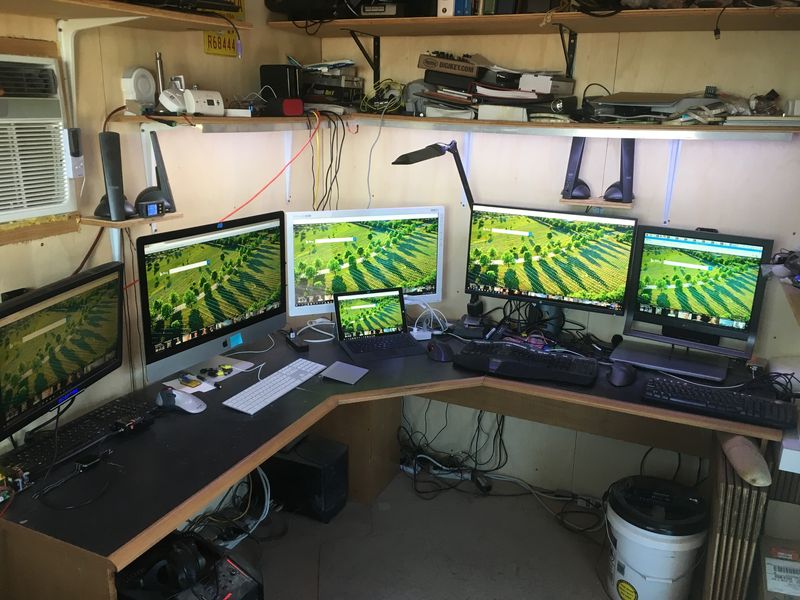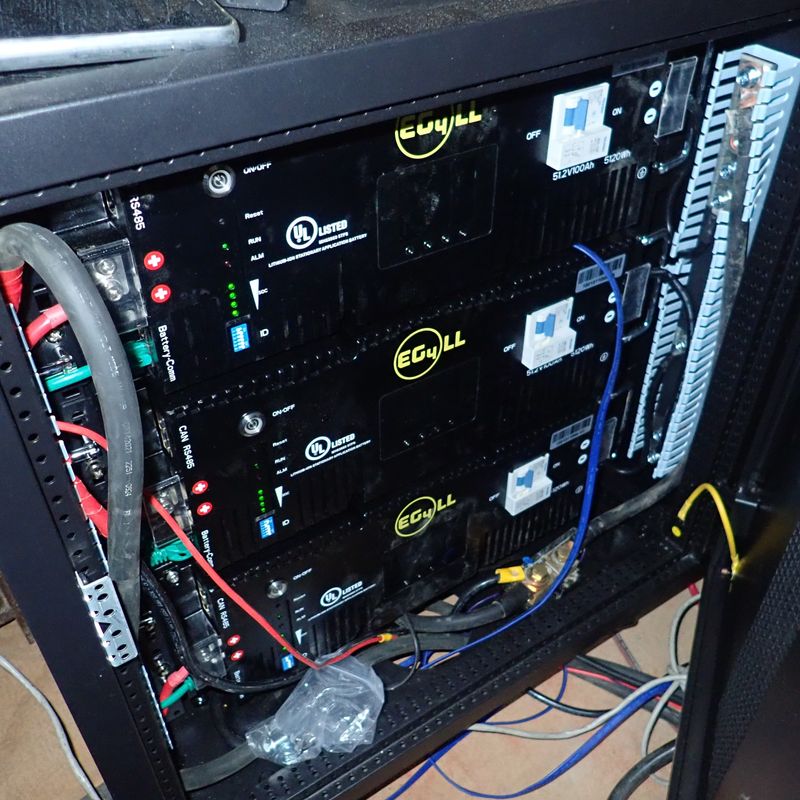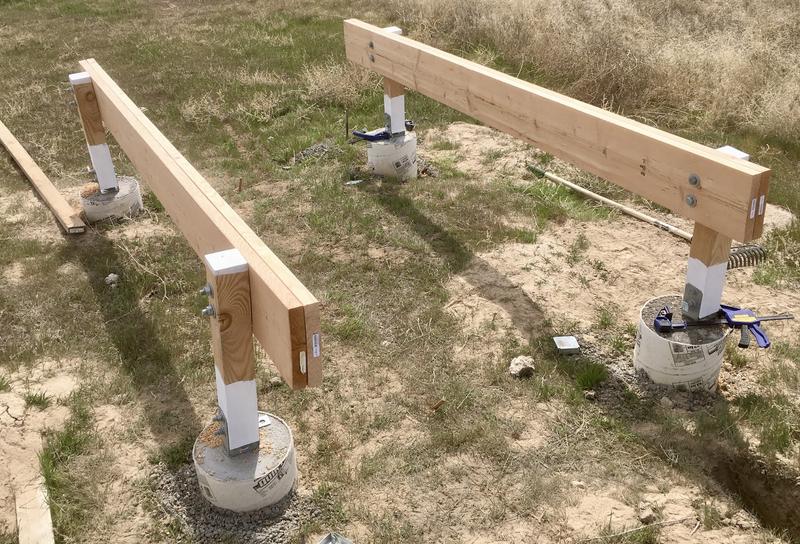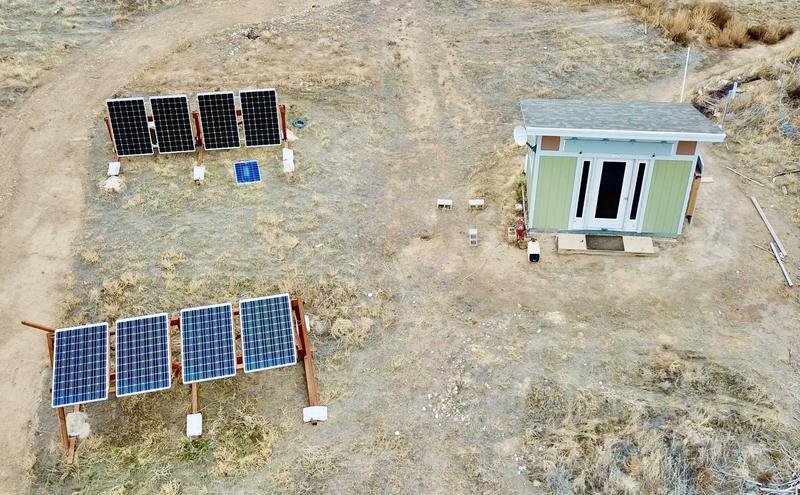Winter is a cold time of the year - and in my solar powered office, the lack of sun in the winter can pose some serious problems for keeping the place warm. Even with good insulation, I need some heat!
My original plan for heat involved using my air conditioner/heat pump/resistive heater paired with an awful lot of optimism about solar production in the winter. You may be able to guess that if I’m writing a whole post on heating, this plan did not work quite as well as I’d hoped…
And you’d be right. My wall unit is great - but I didn’t get enough sun to keep me warm all the time. In other ways, it was too powerful for winter use. But, I’ve found solutions! And as you can see, they work rather nicely!

Read on to find out what I figured out to stay warm in the winter!
Thermal Overview & Insulation Observations
For those who have no idea what I’m talking about here, I built an office out of a Tuff-Shed - and insulated it reasonably heavily for a shed. Rock wool on the walls, rock wool on the ceiling, 2” thick foam board around, and, unfortunately, nothing under the floor because it was delivered fully assembled - though I intend to fix that before next winter.
That insulation arrangement has been serving me well. I’ve found that, generally, if I leave my office at 5PM with the interior temperature around 75F, the temperature at 9AM is around 20F warmer than whatever the overnight low was - though wind will make that a bit lower. There’s 55W of waste heat being dumped into the interior at all points in time, but that’s not even 200 BTU/hr - barely any heat at all.
Yes, this does mean that in the depths of winter with lows below 0F, my office is below freezing in the morning (one morning at 0F, it was 26F inside my office). Did you know that an iMac will ramp the internal fans to 100% if powered on (or woken from sleep) when particularly cold (below freezing)? Apparently it views this as a sensor failure of some sort - so warm things up first! If your computer does do this, put it back to sleep after the insides warm up, wake it again, and it should behave. It’s not a good idea to subject spinning hard drives to this type of abuse either - disconnect those if you care about them.
An easy enough way to tell how well insulated a roof is involves seeing how snow sticks around. I’ve got 2x6 roof construction, stuffed full of rock wool insulation, and covered with another 2” of foamboard - so it’s well insulated, at least on paper (about R28, if you ignore thermal bridging). In reality? Well, the snow just doesn’t melt! This is what the roof looks like after several chilly days of no snow, and me having the office over 80F inside during the day.

Early winter was so nice… later on in the winter, my battery box (the box under the air conditioner) was nearly buried with drifted snow.

I also had issues with keeping the solar panels clear. Snowed over panels don’t produce much power. My south bank of panels was too high to keep clear (I couldn’t reach them to clear them), but I set my north bank to a steep winter angle, and while they did snow up, I could at least clear them with a 2x4 gently brushed over them.
Yes, I know, this isn’t much snow by Montana or North Dakota terms. It’s radically more than this area normally gets, so I didn’t design for it. Lessons learned and all…

Limitations With My Wall Unit
What’s the problem with my wall unit? The main issue is that it uses too much power in the winter! The air conditioner and heat pump pull about 750W when running the compressor, but the resistive coils pull about 1500W.
I went with a fancy unit (Frigidaire FFRH0822R1, about $500 on eBay) that’s capable of operating as an air conditioner, a heat pump (which is an air conditioner in reverse), and a resistive heater. It seems custom designed for a little off grid office like this.

The heat pump feature is nice on paper, and nice for a few weeks in the spring and fall, but in the dead of winter? It’s entirely worthless. It only pumps heat when outside temperatures are over 40F, and if it’s over 40F, the inside of the shed is probably just fine, and a small tweak away from being in the 70F range I prefer. If it’s 40F in the morning, it was probably a low of around 35F overnight, which means the office is still 55F or so - not much of a jump to 70F, and waste heat will do that in a hurry.
If it’s colder than 40F out, I need the heater more, but I’m stuck with resistive coils. Those work out to be a kWh for kWh trade - 1kWh electrical for 1kWh (or 3400 BTU/hr) heat, and that’s simply not something that works well on a cold morning, with a cold battery pack (lower useful capacity) that’s partly drained from running things in the evening and overnight, and zero solar input because of the heavy cloud cover.
It wouldn’t be as big a problem (just an expensive one) if my generator could run the wall unit - but it can’t (at least, not with anything else running). Besides, converting gasoline into electricity to make heat is really, really inefficient.
So, I set out to find myself another option.
Propane Heat
I waffled back and forth between propane and kerosene for interior heat for far too long, and eventually ended up with propane. Propane is easy to find out here (and fairly cheap, since I can fill up at a neighbor’s big tank), but kerosene is $8/gal in small buckets, as I can’t find a kerosene pump at a gas station around here.
If I want, I can also get a conversion kit to run my generator on propane - and this seems a useful capability for next winter (propane burns much cleaner, doesn’t gum up the carburetor, and is usually easier to start in the cold).
There are endless varieties of propane heaters, but since I’m entirely out of wall space to mount large things, I ended up going with a 10k BTU/hr ventless “blue flame” heater - about $100 on eBay.

This is, quite literally, a propane burner in a box, with a high/low/pilot valve on top. The exhaust vents into whatever space the heater is operating in, and ideally you don’t build up too many exhaust products in the air.
But, it works! It heats my space nicely, and I only lose a bit of the heat to the vent airflow I run to try and keep the air clean(ish). The fan on top is to blow the hot exhaust into the corner I’m working in - it helps heat the office up more evenly.
This is my normal “morning heat” - I use it to bring the office up from overnight temperatures (which can be below freezing if it’s very cold out) to something more habitable (65-70F). It takes half an hour or a bit longer, depending on how cold it is inside, but then I can throttle the burner back significantly or turn it off entirely.
Fuel is fed from a 40lb propane tank sitting outside. This holds about 9 gallons of propane, which at 91k BTU per gallon, works out to around 820k BTU of heat in the tank - or a neat 82 hours of operation of my heater on high (10k BTU per hour). At 2 hours a day, that’s two work months of max heat, and I don’t need the propane heat every day. This tank got me through the winter with a gallon or two left sloshing around in the bottom - and it was a brutally cold and dark winter this year.

Venting & Safety
Yes, burning a ventless propane heater in a tiny, well insulated area with little air leakage sounds like a bad idea. Fortunately, I’m aware of this, and have worked around it!
To circulate fresh air in, I have a 120mm computer fan that I tuck in my window when the burner is running. With around 6V out of my bench power supply, it moves enough air to keep my office air clean, without pushing all my heated air out. I’ve also blocked the top of the window with some cardboard to help keep the hot air inside.
Perfect? No. Good enough? Yes. Cheap? Absolutely!

And I know it’s good enough because I have two carbon monoxide detectors in my office. One is a 110V unit, the other is battery powered and has a digital display. I can control the airflow based on the readings here. One slightly annoying issue I’ve discovered is that most carbon monoxide sensors have a cross sensitivity to hydrogen, and I do end up with very low concentrations of hydrogen in my office when the batteries are in absorb and gassing. I spent a while figuring out how I was getting carbon monoxide readings on a clear day with zero combustion heat, and finally discovered the cross sensitivity based on the suggestion of someone on IRC. My battery box has a few passages into the office for cables, and one of them was letting a bit of hydrogen in (quickly resolved).

Out of curiosity (and because I needed to dry my office out), I set up some remote monitoring for my CO levels and left the propane heater running until the oxygen depletion sensor shut it down. My office peaked around 120F, with a peak CO reading of 59ppm. That’s not a great CO level to be in, but it’s not actively dangerous in a short term situation either (and I’m not going to do that with me in there - I assure you, I’d notice 120F). So, as far as I’m concerned, the heater works as advertised and is safe enough for my needs.
Electrical Heating: Folding@Home and BOINC
Propane heat is great for cloudy days - but my office is a solar powered office! If it’s sunny out, I have gobs of power in the form of energetic electrons - and there’s no point in spending money on propane if I’ve got enough power coming in - power from the panels is “use it or lose it” once the battery bank is full, so I may as well use it!
My primary source of heat on a good solar day is my desktop - a reasonably high end CPU and a Radeon 290X. This beast will happily convert about 500W of solar energy into compute - and also heat.

I run Folding@Home on the Radeon 290X, and get a decent amount done on sunny days. This works out to around 250W of heat, give or take.

The CPU cores run BOINC tasks, and mostly focus on World Community Grid. My iMac also runs BOINC, and generates a bit of waste heat as well (though not nearly as much as the desktop).

Additional Electric Heat
The waste heat from the desktop isn’t enough on really cold days, but running both the desktop and my wall unit pushes the inverter beyond maximum sustained power output. A smaller electric heater makes sense - and I have just such a cute little device under my desk.
This fan-and-wire gizmo has a low mode that draws 800W, and a high mode pulling 1500W - but low works nicely, fitting in comfortably under the power limit of my generator or inverter with my desktop running! I don’t use high very often, since the 1500W is what my wall unit pulls (and that has a much larger fan for moving air around).

Solar Gain
Finally, I didn’t really expect that much out of it, but on a sunny day, the sun on my south facing windows adds a huge amount of heat! It’s hard to figure out exactly how much, but the windows are almost uncomfortably warm to the touch on the inside, and I notice that I need radically less heat in the afternoon - there have been some chilly 0F days where waste heat and the solar gain on my windows was enough that I had a fan in the window just to help keep me cool!

Duct Tape Door Sweep
Early in the winter, I discovered a problem with how my door seals around the floor. This is a shed, not a precision building, and, well, the door leaks a bit. Not a problem in the summer, but with the wrong winter winds on a snowy day, it started being a bit of an issue! A “rather significant amounts of snow inside my office where I’d rather it not be” type of issue.

I used what I had laying around for an initial door sweep - duct tape. The original plan involved using this until I got a proper sweep to help keep the snow out, but it turns out the duct tape works so well, I haven’t had to replace it yet! The loose end of the tape gathered enough dust and dirt to be entirely not-sticky, and it slides smoothly along the floor. I’m just going to leave it there until it stops working - but it does a great job of keeping the wind and associated snow out!

Heat Source BTU/hr
It’s helpful to think of my various heaters in BTU/hr. Alternately, you can think of everything in kW. BTU/hr is the standard for heat, but it is a straight conversion from BTU/hr to kW, so I’ll be nice and provide both.
Propane Heater: 10,000 BTU/hr (2.93kW) - 50% more than my inverter can sustain, were that an electric load.
Wall AC/Heater: 8000 BTU/hr cooling (2.35kW), 7000 BTU/hr heat pump (2kW), 3500 BTU/hr resistive coils (1kW). It’s worth pointing out that the heat pump and AC modes only pull 750W electrical - moving heat is easier than generating it.
Under-desk Heater: 2750 BTU/hr (800W), 5100 BTU/hr (1500W).
Desktop Computer: 1700 BTU/hr (500W).
Normal Running Loads: 850 BTU/hr (250W).
Maximum Feasible Heat Output (propane burner, 2kW of electrical loads): 17,000 BTU/hr
How I Heat
With all these ways to make heat, my preferred method of heating is heavily based on how much sun I have to work with on a given day. It can be summarized as, “heating as cheaply as I can.”
If I have a cold, grey day, with a forecast of more clouds, conserving power is important - so I’ll heat almost entirely with propane, keep power consumption down, and probably run my generator some to charge the batteries. I’ve been trying to avoid using the generator to create heat, as that’s insanely inefficient, though I have considered building an air to air heat exchanger off the generator to help heat my space (DIY micro CHP).
On a clear, sunny day? Crank the electrical loads! I usually start the morning with the propane heat and my wall unit (I can run it from the inverter if the computers aren’t all powered up) to bring the temperature up for a while. I’ll shut down the wall unit and switch the desktop on when either my under-load pack voltage hits 48V or I hit 60F, and then just run assorted electric heat throughout the day to keep the temperature up. Usually by the afternoon, the solar gain and the desktop are more than I need, so I have the window open with my vent fan bringing chilly outside air in (and blowing propane-exhaust fouled air out).
On days that are neither heavily cloudy or fully sunny, I just do what makes the most sense for the conditions. I try to ensure my batteries get a full charge at least a few times a week (good for longevity), so if things are iffy, I prefer propane, but I’ll crank up some electric heaters if I’m up into absorb, even if only for 10 minutes.
If I have the power coming in, I heat with electricity. Heating with excess electrons is cheapest, but if that’s not enough, I’ll toss a match into the propane burner and blast away with another nearly 3kW of thermal power!
How Does it Work?
Very, very well.

Once I got the propane heater hooked up, I haven’t had a single problem keeping the office warm. It can be below zero and I can still get the interior temperatures up into the 70s or 80s (though I try for the 70s - 80s are a bit excessive in the winter, unless I’m heating on pure solar, at which point I’ll crank it until I’m comfortable in a t-shirt, because otherwise the power goes to waste).
I’m quite happy with the system I have in place!
Advice to Others
If you’ve got a similar setup and are looking for advice on heating, something similar to what I have is a decent place to start. If you have grid power, just use your wall unit or some space heaters and things will be fine. For something powered by solar, you’ll almost certainly need some amount of propane or kerosene heat in the winter, but given the difficulty of finding cheap kerosene, propane makes more sense (and you can run your generator on it).
For any sort of combustion based heat, you absolutely need carbon monoxide sensors. Just be aware that they can sense hydrogen as well, and will confuse the pants off you until you figure this out (also, you should figure out why hydrogen is getting in - it turns out, my battery box vent had frozen shut).
I’d also suggest a direct vent propane heater, if you have the wall space for it (and can deal with the empty space needed above it). This is a propane heater that sucks air in from outside and vents exhaust outside. They need to be mounted fairly low on the wall, but this is a nicer way to heat (no combustion gasses getting into your space if all is working properly), and most of them have thermostats, so you can set the temperature and have it keep the space warm overnight. They use a bit more propane than a ventless heater, but you don’t need to vent the room as much, so it probably ends up being a bit more efficient all told.
The biggest thing, though, would be to design in heat early on. I didn’t do this, so cold weather turned into a bit of a chilly scramble to figure out the details.
How are you heating your off grid space? Let me know what works for you in the comments!
Comments
Comments are handled on my Discourse forum - you'll need to create an account there to post comments.If you've found this post useful, insightful, or informative, why not support me on Ko-fi? And if you'd like to be notified of new posts (I post every two weeks), you can follow my blog via email! Of course, if you like RSS, I support that too.








